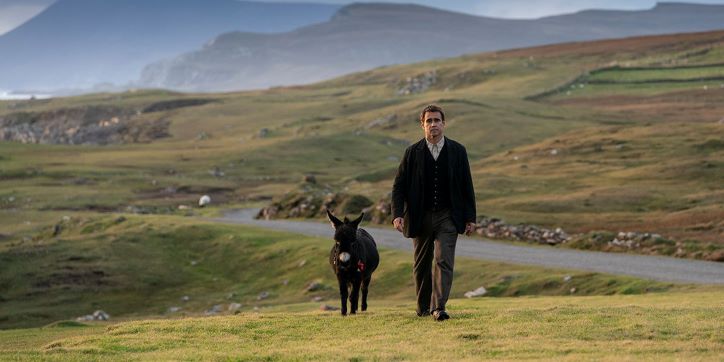![]() After the U.S.-set Three Billboards Outside of Ebbing, Missouri, director Martin McDonagh has gone back to Ireland (to 1923, to be exact) and returned to form with this dark, macabre, obscenity-filled comedy, set in the intimate key of The Beauty Queen of Leenane (1996). His first Broadway breakout hit was a chamber piece with a bloody mother and daughter tug of war that featured matricide. (The play may not have been the best choice as a Mother’s Day outing—my stepmom bemusedly had questions about my choice for this holiday outing.)
After the U.S.-set Three Billboards Outside of Ebbing, Missouri, director Martin McDonagh has gone back to Ireland (to 1923, to be exact) and returned to form with this dark, macabre, obscenity-filled comedy, set in the intimate key of The Beauty Queen of Leenane (1996). His first Broadway breakout hit was a chamber piece with a bloody mother and daughter tug of war that featured matricide. (The play may not have been the best choice as a Mother’s Day outing—my stepmom bemusedly had questions about my choice for this holiday outing.)
On the picturesque but desolate, rocky island of Inisherin, the sparse population includes a dictatorial policeman, the village idiot, and a black-cloaked, pipe-smoking foreseeing crone. In other words, a tourist board’s nightmare. Background cannon fire on the mainland stands in for the ongoing Irish Civil War, and one sign of recent political change is the island’s mail box, which dons a new coat of paint, going from royal red to Kelly green. Apart from this, time has stood still with the locals carrying on traditions, grudges, and superstitions, while only a few recognize that the days are slipping away.
McDonagh wastes no time laying out his setup. With a spring in his step, Pádraic (Colin Farrell) makes his daily afternoon call at the thatched roof cottage of Colm on his way to the pub. After he knocks and hears no reply, he looks in a window and spots Colm (Brendan Gleeson) sitting in the dark with his back to the window, smoking but otherwise not moving. Pádraic continues on his way, perplexed and dazed, as is everyone else when he arrives at the pub solo, and still later Colm as comes in and sits alone.
When Pádraic confronts Colm on why he no longer wants to have a pint with him, he hasn’t considered what the answer may be and is unprepared for the response: “I just don’t like you no more.” The following day, when the two face off again, Colm admits his behavior was harsh, but, hardly gently, he adds he’s tired of their “aimless” chit chat: “I don’t have a place for dullness anymore,” and he would rather devote more time to writing music. Scene by scene, there is a steady dawning that Colm may have a point: Pádraic is dim.
Their abodes reveal much about the men’s status and interests too. Pádraic’s dark, simply furnished cottage has a crucifix and books as decorations. Colm’s two-story, sun-filled home looks more like an artist’s studio, with marionettes, masks, other art. A Victrola drowns out the sound of the nearby sea.
As a result of Pádraic’s endless entreaties, Colm makes a demand, a threat really, at their third showdown: If Pádraic speaks one word to him ever again, Colm will take a drastic measure and maim himself. Acting as referee is Pádraic’s sister, Siobha?n (Kerry Condon), who lives with her bachelor brother—no one seems to be married on the island nor are there many young people around, and Siobhan is apparently the only islander who reads books.
Given Colm’s long-held bluntness, the kerfuffle shifts from the deterioration of a bond to the humiliation of Pádraic and what he’ll do to retaliate. The story line pushes and pulls the audience this way and that. Like the ever hopeful Pádraic, the possibility of a détente of sorts comes within reach, only to be squashed. Given the director’s previous plays and films, the audience shouldn’t be too surprised when Colm carries out his threat.
McDonagh emphasizes the tit-for-tat conflict that breaks out between the two former friends, but without probing psychologically. Siobhan’s suggests that Colm’s just depressed to explain his sudden rejection of Pádraic, and she may be onto something. The first question the priest asks him at the weekly confession is, “How is the despair?” Nevertheless, one question pops up: In issuing his threat of self-mutilation, why would Colm give Pádraic so much power?
Though McDonagh’s story is gritty, grim, and grotesque, the location lends it an almost epic-like grandeur. It follows the manner of many recent films where the production values increase tenfold based on location, location, location. (It was filmed off Ireland’s west coast on Inishmore and Achill Island, both standing in for the fictional Inisherin.) Balancing the onscreen vistas and the script’s pitch-black undercurrents, Carter Burwell’s score has the calmness of a lullaby with hints of thriller-like plot twists to come. The soundtrack takes on the form of the mythical banshee referenced in the movie, a wailing spirit foreseeing death.
With the addition of McDonagh’s acid-laced movie, 2022 has become the year of the donkey. The winner of the grand jury prize at Cannes, EO, featured its titular donkey undertaking a continental journey of survival in Jerzy Skolimowski’s visually and musically intoxicating odyssey. Here, Jenny, a miniature donkey and Pádraic’s one steadfast companion, has fewer tribulations. In fact, she is spoiled rotten, having the freedom to roam inside the siblings’ cottage despite Siobha?n’s complaints of the accompanying manure.
At the Q&A after the North American premiere at the Toronto International Film Festival, McDonagh said he wanted to explore a topic that hasn’t been featured prominently on screen, the breakup of a friendship. His clever screenplay expands upon this straightforward premise, and the ramifications ricochet, sometimes viscerally and other times so subtly they may go unnoticed. With this role, Farrell takes on the title of the world’s oldest man-child: needy, pouty, vulnerable, though with swagger and bluster to boot. With nary a wink to the camera, he plays it straight, anchoring the farcical scenario. Gleeson, on the other (dismembered) hand, matches Farrell. Both actors play their roles with deadly seriousness, while each member of the sterling supporting cast has a moment to steal the film with a glare, a snarl, or a double-take.
Of the all of the big-name titles that premiered over the course of the Toronto festival (Empire of Light, The Fabelmans, The Son, Women Talking, among others), The Banshees of Inisherin ranks above the rest as the most well-crafted, all-around accomplished entry to the awards season so far. Despite the dreariness of the islanders’ lives and the violence embedded into the plot, it is never less than exuberant.
The Banshees of Inisherin will begins its U.S. theatrical release on October 21.







Leave A Comment